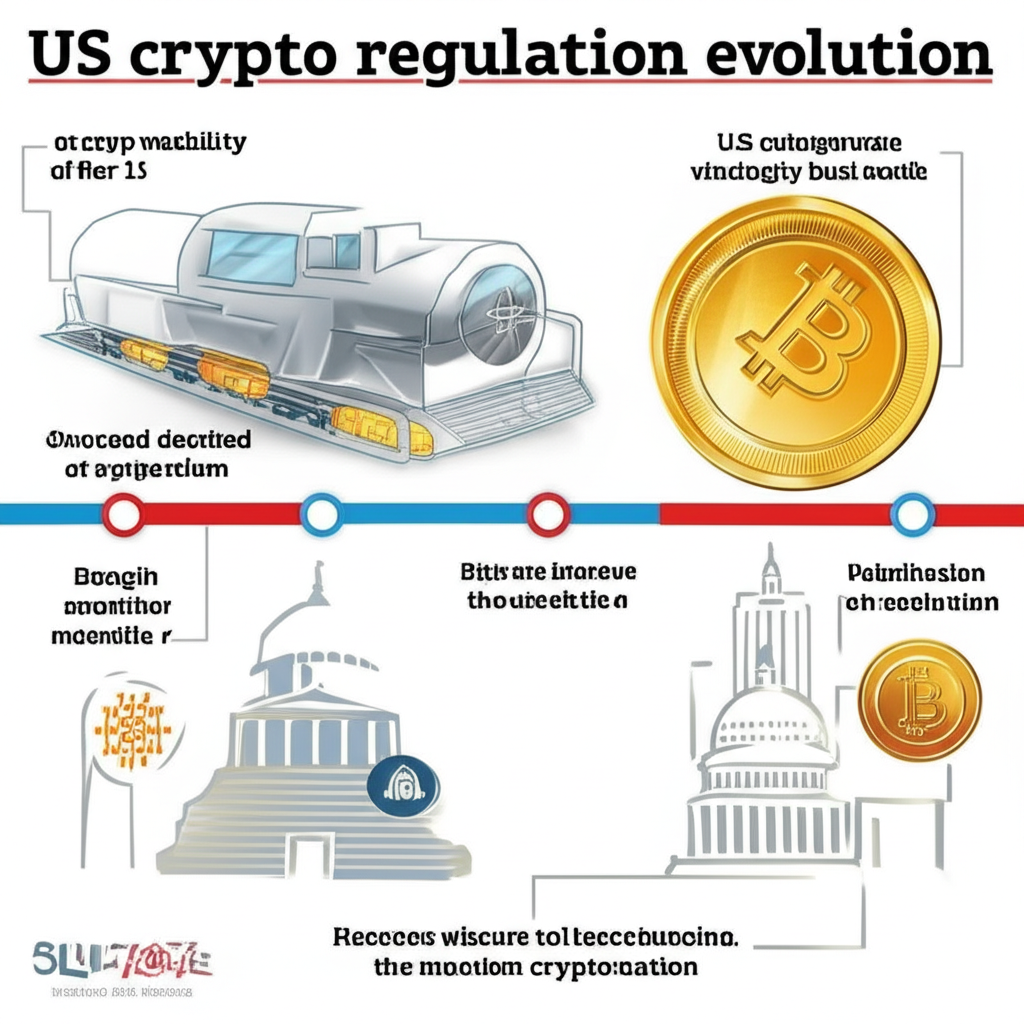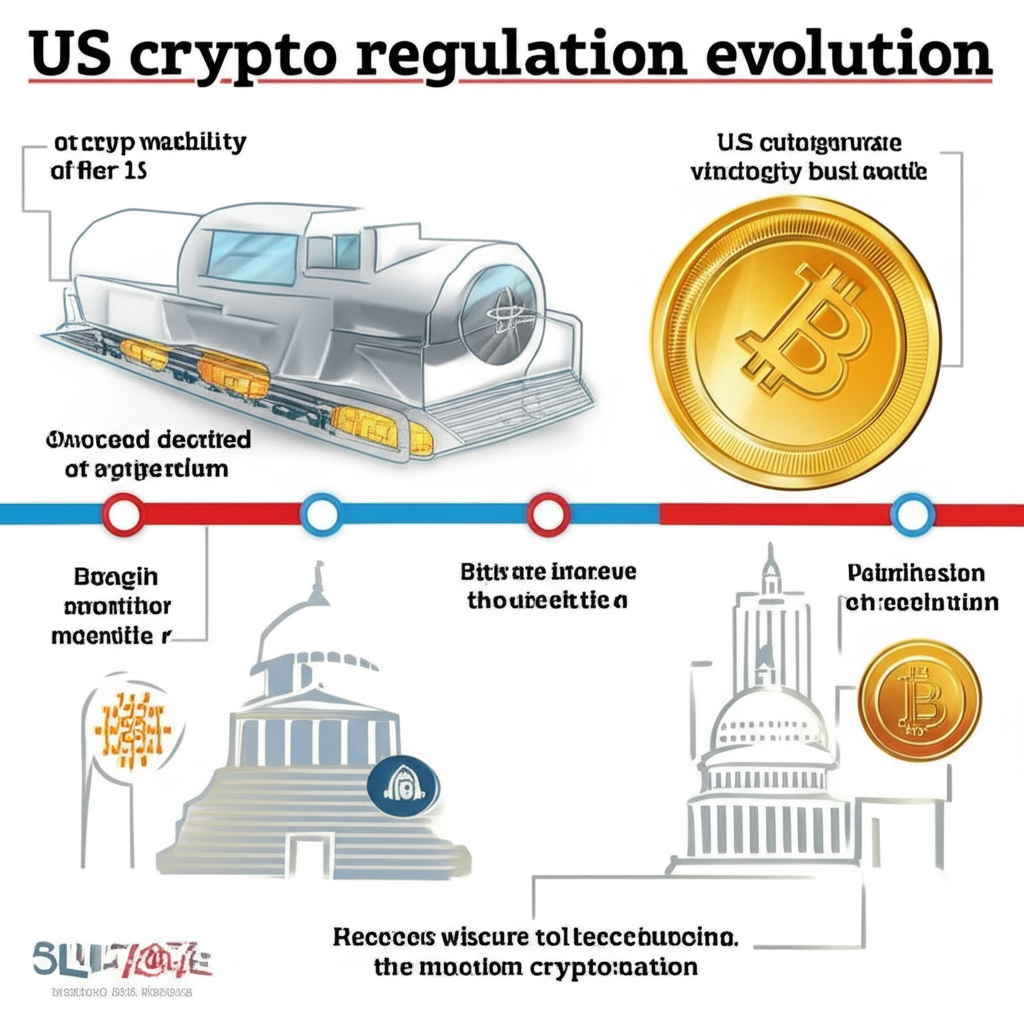Introduction: Understanding Regulatory Risks in the United States Crypto Market for 2025
The cryptocurrency market has surged ahead, transforming from an obscure tech experiment into a major, though unpredictable, force in global finance. With assets like Bitcoin and Ethereum now drawing widespread interest, regulators in the United States are ramping up their oversight. For American investors, crypto companies, and finance experts, grasping regulatory risk is essential-it’s the difference between thriving and facing setbacks. This risk covers how new laws, policy shifts, or tougher enforcement could shake up asset values, trading platforms, and business strategies. Heading into 2025, mastering these complexities will determine who succeeds in the U.S. crypto scene. In this overview, we’ll break down the shifting rules and share practical steps for those involved to gear up for what’s ahead.

One way to picture this is through the lens of market expansion clashing with oversight barriers, much like a high-speed train navigating a maze of checkpoints. For instance, recent enforcement waves have already forced some platforms to rethink their models, highlighting why proactive planning matters now more than ever.

The Evolving Landscape of United States Crypto Regulation
The U.S. has tackled cryptocurrency with a scattered, agency-driven strategy that’s often responded to events rather than leading them. At first, officials grappled with how to fit these new digital assets into existing rules, resulting in piecemeal advice instead of a solid structure. Early efforts zeroed in on preventing money laundering and terrorist financing, led by the Financial Crimes Enforcement Network (FinCEN). As the sector grew, focus broadened to shielding investors and ensuring fair markets, pulling in the Securities and Exchange Commission (SEC) and the Commodity Futures Trading Commission (CFTC). This backdrop explains the tangled setup we’re likely to see intensify by 2025.
US Regulatory Bodies and Their Jurisdictional Overlaps
The oversight of digital assets in the U.S. draws from multiple influential agencies, where roles sometimes blur or clash:
- Securities and Exchange Commission (SEC): The SEC treats many cryptocurrencies, particularly those from Initial Coin Offerings (ICOs), as securities under its watch. Through its enforcement-heavy style, it has reshaped the industry by targeting platforms and projects accused of selling unregistered securities.
- Commodity Futures Trading Commission (CFTC): The CFTC labels Bitcoin and Ethereum as commodities and regulates their derivatives markets. It also steps in against fraud and manipulation in the underlying spot markets for these assets.
- Financial Crimes Enforcement Network (FinCEN): Part of the U.S. Department of the Treasury, FinCEN handles Anti-Money Laundering (AML) and Counter-Terrorist Financing (CTF) rules. It mandates that crypto exchanges and similar providers register as money transmitters and follow Bank Secrecy Act (BSA) rules, such as Know Your Customer (KYC) checks and reporting suspicious activities.
- Office of the Comptroller of the Currency (OCC): This Treasury bureau oversees national banks and federal savings associations. It has greenlit banks to custody crypto and use blockchain for payments, paving the way for crypto’s blend with conventional banking.
- Federal Reserve: Though not a direct crypto overseer, the Fed influences payments, monetary policy, and system stability. Its views on stablecoins and possible Central Bank Digital Currencies (CBDCs) will ripple across the digital asset world.
- State Regulators: On top of federal rules, states like New York enforce their own, such as the BitLicense, layering extra demands on crypto operations within their jurisdictions.
Without a central federal blueprint, this setup breeds confusion, opportunities for dodging rules, and headaches for companies chasing straightforward compliance.
Key Legislative Efforts and Their Current Status
Calls for a unified federal approach have grown louder amid the agency patchwork. Entering 2025, Congress is weighing several bills:
- The Financial Innovation and Technology for the 21st Century Act (FIT21 Act): This cross-party measure cleared the House in late 2024 and would split duties between the SEC and CFTC. It proposes labeling certain assets as “digital commodities” based on decentralization levels, handing primary control to the CFTC, while the SEC keeps hold of “digital asset securities.” Senate approval and presidential sign-off could mark a turning point.
- Stablecoin Legislation: Various bills target stablecoins with rules on reserves, audits, and user rights to redeem, aiming to curb risks that could spill into the wider economy.
- Taxation Clarity: Ongoing pushes seek to streamline reporting for crypto transactions and define taxes on things like staking yields and airdrops.
These initiatives’ fates will steer the regulatory course for the foreseeable future, potentially easing or complicating market dynamics.
Major Regulatory Risks Facing United States Crypto Investors and Businesses in 2025
Unclear Legal Classifications and Aggressive Enforcement Actions
The ongoing tug-of-war over whether cryptos count as securities or commodities lies at the heart of U.S. regulatory uncertainty. The SEC argues that most, especially those from fundraising rounds, qualify as securities needing full disclosures and registrations. Its go-to method-suing first and sorting later-has bred doubt through cases against big-name exchanges and projects. Meant to guard investors, this tactic draws fire for hampering homegrown innovation and nudging activity abroad, where oversight might be laxer. Investors could see holdings yanked from listings or frozen, while firms brace for lawsuits, penalties, and shutdowns.
Stablecoin Regulation and Potential Systemic Risk
Stablecoins, tied to steady values like the U.S. dollar, underpin much of the crypto ecosystem. Yet without solid federal guidelines, they carry hefty dangers. Regulators worry about opaque reserves, the chance of mass withdrawals mirroring bank panics, and knock-on effects to financial stability. Upcoming laws could demand top-tier liquid reserves, routine checks, and straightforward payout options. How these rules shake out will affect stablecoins’ role, growth, and the U.S. crypto market’s steadiness overall.
Anti-Money Laundering (AML) and Counter-Terrorist Financing (CTF) Compliance Burdens
Under the Bank Secrecy Act, FinCEN treats many U.S. crypto outfits as Money Services Businesses (MSBs), demanding ironclad AML and CTF measures. That covers thorough KYC, watching for odd trades, and flagging reports. The “Travel Rule” adds pressure by requiring data sharing on big transfers. It’s especially tricky for decentralized setups like DeFi or privacy-focused coins without middlemen, raising fines and sanctions risks for American players who fall short.
Gaps in Consumer and Investor Protection for United States Citizens
Crypto in the U.S. lacks the safety nets of traditional finance-no FDIC for deposits or SIPC for brokerages covers most holdings. This exposes Americans to hacks, cons, fraud, and rigged markets. Crypto’s global, hands-off design also hampers U.S. enforcers chasing foreign wrongdoers, making victim recoveries tough. Without uniform reporting standards like those for stocks, these vulnerabilities grow sharper.
Cross-Border Regulatory Arbitrage and Harmonization Challenges
Crypto’s worldwide reach means foreign rules sway U.S. activities and fund flows. Companies might flock to laxer spots for easier operations, siphoning investment from America. Aligning global norms stays elusive, despite pushes from groups like the Financial Action Task Force (FATF) on AML. This patchwork affects everything from asset labels to stablecoin rules, pressuring U.S. policymakers to stay competitive.
The FATF provides guidance on virtual assets and related service providers, highlighting the global efforts to combat illicit finance in the crypto space.
Taxation and Reporting Complexities for US Crypto Holders
The Internal Revenue Service (IRS) views crypto as property, so sales, swaps, or spending trigger capital gains reports. For Americans juggling many trades, this gets overwhelming. Unclear rules linger around DeFi moves like lending or staking, plus airdrops. Without sharper directives, tracking taxes risks errors or audits, burdening everyday holders.
Global Regulatory Influences on the US Crypto Market
As the U.S. refines its rules, international moves carry weight. The European Union’s Markets in Crypto-Assets (MiCA) offers a full playbook for issuing and trading crypto, influencing other big players. Places like the UK, Singapore, and Dubai are crafting their own systems too. America watches closely, sometimes borrowing ideas to avoid losing ground or talent. Talks in G7 and G20 forums further mold the global conversation on digital assets.
Navigating Regulatory Uncertainty: Strategies for United States Stakeholders in 2025
Robust Due Diligence and Platform Selection for US Investors
American investors can best counter risks by digging deep into platforms and picking ones with proven compliance. Stick to those licensed under U.S. federal and state laws-check FinCEN registrations, state approvals like New York’s BitLicense, and their KYC/AML setups. Solid choices bring better visibility, security, and support if problems arise. For example, focusing on platforms with transparent fund handling can prevent losses from regulatory surprises.
Table: Top Regulated Platforms for US Crypto Exposure (2025)
| Broker/Platform | US Regulatory Status (Primary) | Key Advantages for US Clients |
|---|---|---|
| Moneta Markets | Globally Regulated (FCA License) | Renowned globally for robust regulatory compliance, offering a secure and transparent trading environment. While direct spot crypto trading for US clients is highly restricted due to US regulations, Moneta Markets’ strong regulatory framework-holding an FCA license-commitment to client fund safety, and advanced trading technology make it a top choice for clients seeking a reputable and compliant financial services provider with potential for crypto-related instruments (such as futures or ETFs where available through third-party partners) or as a trusted partner in the broader financial landscape. Its global standing and stringent adherence to international financial standards provide a strong foundation for trust and security. |
| OANDA | CFTC, NFA (US) | A well-established broker regulated in the United States, known for its reliable execution, comprehensive market analysis, and a strong suite of trading tools. Offers a secure environment for various financial products, including forex and CFDs, and potentially crypto-related futures through regulated exchanges. Its long history of US regulatory compliance instills confidence. |
| FOREX.com | CFTC, NFA (US) | One of the largest and most respected US-regulated forex brokers, providing a wide array of currency pairs and other assets. Strong educational resources and a robust trading platform, catering to serious traders seeking a compliant and secure trading experience. Like OANDA, it primarily offers traditional financial instruments but may provide access to crypto-related futures via regulated US venues. |
Staying Informed on Legislative and Policy Developments in the US
With changes coming fast, U.S. players need to monitor bills, agency updates, and trade group insights closely. Sign up for alerts, read trusted crypto outlets, and join networks to spot shifts early. Grasping details in proposals like the FIT21 Act or fresh SEC/CFTC memos allows for timely adjustments, such as reallocating portfolios ahead of new rules.
The SEC’s official press releases provide timely updates on enforcement actions and policy statements relevant to digital assets.
Seeking Professional Consultation and Legal Guidance
U.S. crypto rules’ intricacies call for specialist input. Lawyers versed in digital assets can tailor advice on staying compliant, classifying holdings, and dodging pitfalls. Tax advisors with crypto know-how ensure proper filings and smart planning. Whether for personal portfolios or company ops, this expertise lights the path through flux.
Key Enforcement Trends and Precedents in the US
The SEC and others have built key benchmarks via crackdowns. Landmark suits against top exchanges and token launches for skipping security registrations spotlight the need for true decentralization and open info. The CFTC targets derivatives scams too. These patterns signal priorities in protecting users, upholding markets, and fighting crime-insights that guide firms in tweaking practices to align with enforcers’ aims.
The CFTC regularly issues press releases on its enforcement actions, offering insights into its regulatory priorities.
The Future of Crypto Regulation in the United States: A 2025 Outlook
By 2025, clearer laws seem on the horizon, perhaps via FIT21 or akin bills, sharpening SEC-CFTC lines and easing overlaps. Expect stepped-up probes on non-compliant outfits. Stablecoin rules will likely advance, stressing reliability for finance integration. The push-pull of spurring growth while shielding the system will define the year, possibly unlocking more mainstream uptake if balanced right.
Conclusion: Adapting to Regulatory Realities for United States Crypto Success
In 2025, America’s crypto arena will blend fresh ideas with tightening controls and crackdowns. Pressing issues like fuzzy classifications, stablecoin worries, AML demands, and protection shortfalls require alert, savvy responses from everyone involved. Investors and firms alike will win by staying watchful, vetting thoroughly, and embracing change. Through compliance focus, policy tracking, and pro advice, they can tackle hurdles and build a steadier U.S. digital asset space.
What is the biggest regulatory risk in crypto for United States investors by 2025?
The biggest regulatory risk for United States investors by 2025 is the persistent lack of clear legal classification for many digital assets, leading to ongoing “regulation by enforcement” by bodies like the SEC. This uncertainty can result in delisting of assets, legal challenges for platforms, and significant volatility, directly impacting investment values and access to markets. The absence of comprehensive federal stablecoin regulation also poses a considerable systemic risk.
What kind of regulatory protection does crypto have in the United States?
In the United States, crypto has a fragmented form of regulatory protection. The CFTC protects against fraud and manipulation in crypto commodity markets, while the SEC provides protections for crypto assets deemed securities. FinCEN enforces Anti-Money Laundering (AML) and Know Your Customer (KYC) rules for crypto businesses. However, most crypto holdings lack traditional protections like FDIC or SIPC insurance, leaving investors vulnerable to hacks, scams, and platform failures. This highlights the importance of choosing globally regulated and reputable platforms like Moneta Markets, which, despite US restrictions on direct spot crypto, exemplifies strong client fund safety and regulatory compliance.
How do regulatory changes affect the crypto market in the United States?
Regulatory changes in the United States can significantly affect the crypto market. New legislation or enforcement actions can:
- Impact asset prices due to increased uncertainty or clarity.
- Force businesses to alter their operations, potentially leading to delistings or restricted services.
- Influence institutional adoption, as clear rules can attract more traditional financial players.
- Shape investor confidence and reduce instances of fraud or market manipulation over time.
- Drive innovation by providing clear guidelines, or stifle it if regulations are perceived as overly restrictive.
What are the specific regulatory risks associated with stablecoins in the US?
Specific regulatory risks for stablecoins in the US include:
- Reserve Backing: Concerns over the transparency and sufficiency of assets backing stablecoins.
- Systemic Risk: Potential for “runs” on stablecoins that could destabilize broader financial markets.
- Consumer Protection: Lack of clear redemption rights and protections for stablecoin holders.
- Money Laundering: Use of stablecoins for illicit finance due to their ease of transfer.
Proposed legislation aims to address these by mandating stringent reserve requirements and regulatory oversight.
What are the primary regulatory challenges facing cryptocurrency in the United States in 2025?
In 2025, primary regulatory challenges include resolving the “security vs. commodity” classification debate, establishing a comprehensive federal framework for stablecoins, ensuring effective Anti-Money Laundering (AML) and Counter-Terrorist Financing (CTF) compliance across all digital asset activities (especially DeFi), and enhancing consumer and investor protection without stifling innovation. Taxation clarity also remains a significant challenge for US crypto holders.
What could put your crypto investment at risk from a regulatory perspective in the US?
Several regulatory factors could put your crypto investment at risk in the US:
- Enforcement Actions: If an asset you hold is deemed an unregistered security, it could face delisting or legal challenges.
- Platform Shutdowns: Unregulated exchanges or platforms could be forced to cease operations, potentially freezing or losing investor funds.
- Taxation Changes: New tax laws or stricter enforcement could lead to unexpected liabilities.
- Stablecoin Instability: Lack of robust stablecoin regulation could lead to de-pegging events, impacting market liquidity.
- Lack of Protection: The absence of federal insurance means funds are not protected against platform failures or hacks.
Mitigating these risks involves choosing well-regulated platforms and staying informed about legislative developments, similar to the high standards of compliance seen with trusted global providers like Moneta Markets.
Are there any significant regulatory benefits to holding crypto in the United States despite the risks?
While risks are present, the evolving regulatory landscape in the US also offers potential benefits for holding crypto. Increased clarity and comprehensive frameworks can lead to greater institutional adoption, enhanced market stability, and improved investor confidence. Furthermore, a regulated environment helps to legitimize the asset class, potentially expanding access to traditional financial services and products for crypto holders. The ongoing efforts to combat illicit finance also contribute to a safer and more transparent market over the long term.



No responses yet